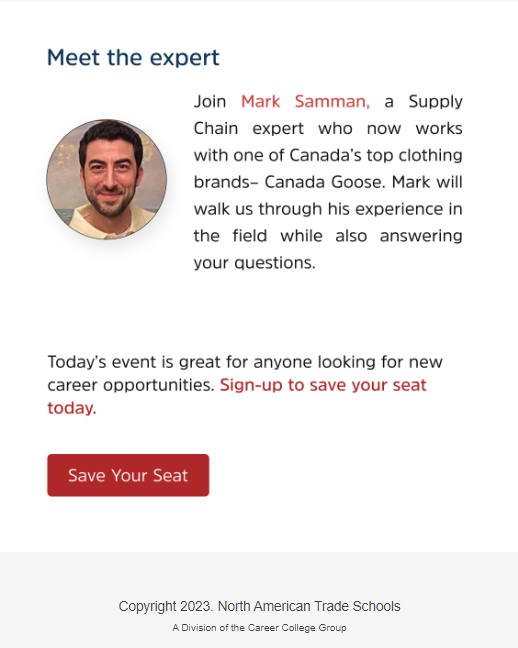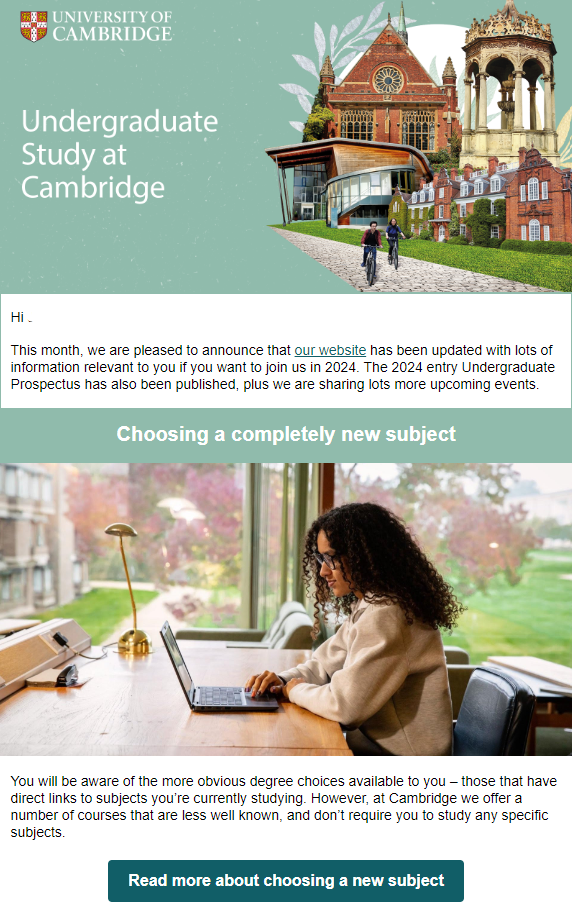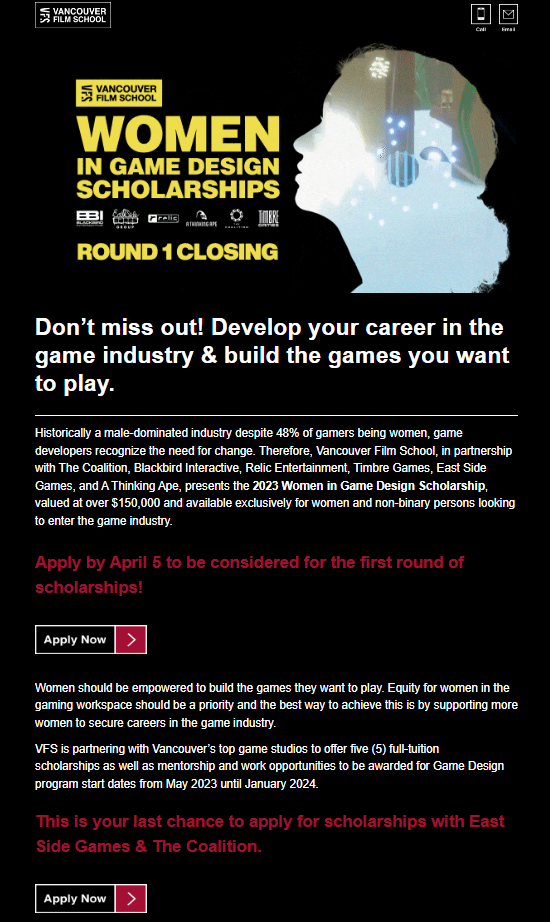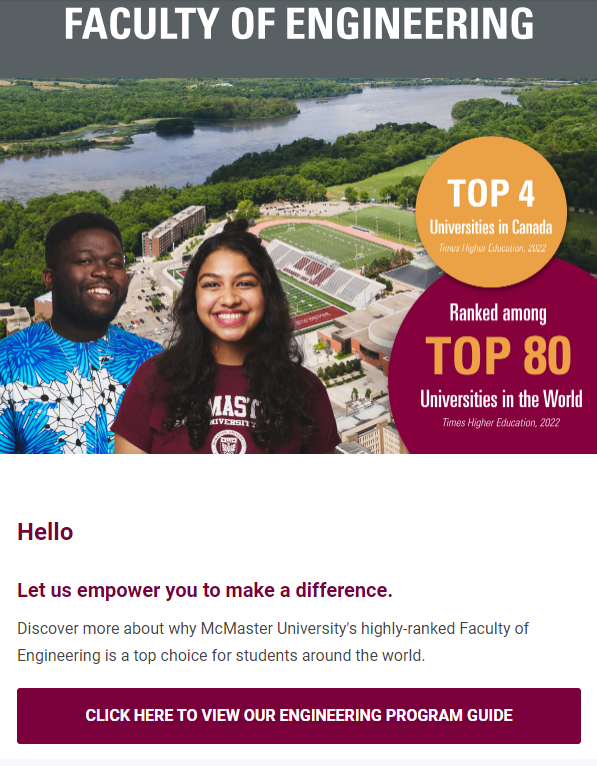It’s undeniable that schools looking to reach prospects more directly need to develop a higher education email marketing strategy. Various factors make up an impactful email marketing campaign—from an enticing subject line to engaging copy—and they all make a significant difference when it comes to attracting prospects and maintaining their interest.
One of these important factors is a call to action (CTA) that actually works. By applying education email CTA best practices, your school can improve its email conversion rates and connect more effectively with its prospects. Read on to discover our top tips and strategies.
Understanding CTAs and What Makes Them Unique in Emails
At its core, a CTA is a prompt that encourages prospects to take a desired action. This action would keep them engaged longer with your school, deepening their relationship with your brand and guiding them to the next stage of the admissions funnel.
Often, these CTAs motivate prospects to apply to a program, schedule a personal meeting, register for an event, or even follow your school’s accounts on social media. In the case of a call-to-action email, these CTAs can appear as hyperlinked text or clickable buttons. Either way, they require a combination of compelling copy and eye-catching design to generate results.
CTAs are essential to practically every marketing campaign, especially when making your emails stand out. They make emails more interactive and play a big role in converting email subscribers into sales leads, directly contributing to enrollment. What makes an email CTA different is that it needs to be compact enough to fit in an email element. That means they need to be short, naturally fitting into a relatively brief email message while also being visually appealing and compelling to click on.
1. Ensure Your School’s Email CTAs are Relevant to Your Prospects
A good email has a clear purpose, and that is the result of a school’s solid understanding of its marketing goals and target audience. You’ll need to decide what you want your campaign to accomplish before creating the content and call to action. Is the goal to encourage application submissions, event registrations or blog post exploration? Key email CTA best practices include factoring for these kinds of questions.
Your CTA will reflect your marketing goal, so you’ll want to make it as clear and relevant to your prospects as possible. This way, they’ll know exactly where they’re going once they click. Besides, having a clear goal can also help you measure the performance of your email and its call to action. You can monitor how much traffic your CTA generates and, depending on your results, revise your goals for a better outcome.
To help with your efforts, you’ll want to rely on accurate and reliable student personas. The insights revealed through these semi-fictional representations of your prospects will guide your content efforts. That’s because it can help you choose email subject ideas that matter to them, giving you an idea of what needs to be highlighted in your CTAs.
Example: In an email targeting prospects interested in supply chain and logistics, North American Trade Schools provides all the necessary details for an upcoming event to prompt registration. The goal of the email is to generate leads, using the “register for free” CTA to direct prospects to a specific landing page:


Source: North American Trade Schools
The CTAs in this email all direct to the same link and make it obvious where prospects will go once they click. Emails that adopt the same approach, using top email marketing content tips, are likely to succeed with prospects—especially when it comes to CTAs in a cold email, where prospects have yet to build trust with your school.
2. Create Engaging Copy with a Compelling Offer
With a clear purpose and personas in mind, you’ll be able to draft the content of an email and develop a CTA that works. This process involves a creative email subject line as well as a compelling narrative that seamlessly guides prospects to your email call-to-action. Due to the brief nature of emails, these CTAs need to be simple and short—focused on a single action so as not to overwhelm readers.
You’ll want your CTAs to make an impact, especially in an email where you’re trying to entice a specific action. For this reason, your word choice and tone of voice make a big difference. Instead of using generic words with weak and passive verbs, you’ll want to use dynamic action verbs that more accurately describe what you want prospects to do. Words like “apply,” “register,” “sign up,” “learn,” and “read” are a great start.
Not only would this strategy create simple and easy-to-understand CTAs, but it would also make prospects feel like they’re being directly spoken to. When you’re being concise with your CTA copy, remember that you can provide additional context in the message of the email itself. The text surrounding the CTA should contribute to that CTA’s overall impact.
As you’re writing your CTAs, consider which stage prospects are in the admissions funnel and craft a compelling offer that would interest them. This way, your call-to-action sales email will push prospects further toward conversion. Here, it may be helpful to focus on your student persona’s specific motivations and concerns, ensuring that they have all the information they need and that they feel comfortable taking the next step.
Example: The University of Cambridge targets prospects at the top of the funnel (TOFU), informing them of the various subjects and programs on offer. The goal of the email is to spark prospects’ curiosity and entice them to visit the school’s academic catalogue. The CTA featured in the email uses action verbs, remaining specific as well as brief:

Source: University of Cambridge
Interested in generating more leads and boosting conversions through your email CTAs? Our team of email marketing experts can help you achieve your goals. Reach out today to gain personalized email marketing insights!
Create a Sense of Urgency or Scarcity in Your School’s Email CTAs
One of the top email best practices includes creating a sense of urgency so that prospects act faster. Your school can create this sense of urgency through careful word choice. The following list of words and phrases can be extremely effective in getting the job done:
- Now
- Today
- Last chance
- Hurry
- Don’t miss…
In addition to urgency, your email CTA can create a sense of scarcity—which can increase the perceived value of your email offer. This, in turn, will make what you’re offering sound all the more enticing. Words that hint at scarcity include:
- Limited
- Exclusive
- Few
- Only
Example: The Vancouver Film School creates a sense of urgency by using the phrases “Last Chance” and “Don’t Miss” in its email subject and in the body of its email. The consistent use of these types of phrases encourages prospects to hurry, boosting the chances of them clicking on the CTAs faster:


Source: Vancouver Film School
Opt for Dynamic Copy when Integrating Email CTA Best Practices
Research shows that segmentation and personalization in email marketing can generate great results. Specifically, personalized emails can boost click-through rates (CTR) by 14% and conversion rates by 10%. By integrating personalization into your school’s email CTAs, you can begin developing dynamic CTAs—potentially one of the best CTAs for email.
Dynamic CTAs change depending on a user’s behavior, background, history, or preferences. These CTAs can resonate more effectively with their target audience since the offer automatically changes to better suit the needs and interests of the user.
This is made possible by your customer relationship management (CRM) software, which can track your contacts’ behavior and allow you to create segmented lists for targeted email campaigns. You can set up these segments based on specific criteria – such as demographic or lifecycle information – and then align your CTA offers to the right segment. The result will be an email that prospects are actually interested in opening, with CTAs that will more likely get them to respond.
Example: McMaster University sends out a special email to prospects who have shown specific interest in its engineering programs. The content reflects the type of information these prospects will want to consume, and the CTA clearly calls out the engineering program for added personalization:

Source: McMaster University
3. Utilize an Eye-Catching Design Using Email CTA Best Practices for Your School
A well-designed CTA is essential to attracting your prospects’ attention and encouraging them to take action. To make them instantly stand out, it’s best to avoid using plain hyperlinked. Instead, turn towards creating eye-catching buttons with highly contrasting colors and legible fonts. You want these colors to enhance readability and not detract from it. Here, it can help to stick to your school brand’s color palette and choose a combination of colors that are easy on the eyes.
Generally speaking, you want your CTAs to look clean and simple. This gives them a modern look that makes your school messaging feel more contemporary. It can also help make your emails feel less cluttered, boosting their scannability. By following these email CTA best practices and taking these precautions, you can decrease the chances of overwhelming your prospects or turning them away from your content.
Example: McGill University’s School of Continuing Studies uses contrasting colors that reflect the school brand in its email CTAs. The CTA styling and the font in use are simple, promoting legibility while giving off a contemporary feel:

Source: McGill University School of Continuing Studies
Interactivity can make a button more pleasing to engage with, increasing the chances of conversion. Research shows that interactive email content can increase click-to-open rates by 73% and that 82% of survey participants prefer interactivity over traditional static emails. Using interactivity in your CTAs makes them appear more clickable, directing users where you want them to go more clearly and enticingly. This can be done through something as simple as a hover effect over your CTA buttons.
Example: The International Institute for Management Development (IMD) uses interactive CTAs to encourage conversions. The first image shows how the CTA appears when prospects first open the email, and the second image reveals how the CTA changes when prospects hover over it on their desktop:


Source: International Institute for Management Development
You also want your CTAs to be mobile responsive so that they appear just right no matter what screen prospects use to view your email. It’s a good idea to consider the size of your CTA as well—you don’t want it to be too big that it distracts from the overall message, nor do you want it to be too small that it becomes hardly noticeable. It can help to look at various email CTA examples to get a rough approximation of how to size them in your strategy.
Pro Tip: Using images or illustrations – such as a clickable photo of students in class with superimposed text prompting prospects to click and learn more – can make your CTAs more eye-catching. However, it’s important not to depend solely on these types of CTAs since some email providers may block images from loading at first.
4. Prioritize Clear CTAs with Impactful Placement When Applying Email CTA Best Practices
Once you’ve sorted the copy and design of your CTA, you’ll need to figure out the best placement for it. According to email call-to-action best practices, you’ll want your CTA to feel like a natural part of your overall message. This means structuring your email to build up to the CTA, which would often be placed toward the end of your email content copy.
For extra impact, you can integrate this CTA throughout your email. When doing so, stick to a single call to action and be sure to repeat it sparingly so that it isn’t detracting from the email reading experience. Your placement will also depend on the length of your email, which you typically want to keep short. You can include a single CTA in the middle and one in the end, as an example.
Example: The Toronto Film School takes this approach in its emails to prospects, placing a brief and direct CTA at the top of the email as well as another at the end:

Source: Toronto Film School
Placing CTAs where they’re visible on the first scroll is also a solid strategy, but remember that some emails require additional context for CTAs to convert. Since English speakers read from the top left to the bottom right, it makes sense to put CTA at the bottom or right side of your email content. That said, the goal should always be to align the CTA with the user experience. This way, prospects never have to scroll back up to hunt for a specific CTA after reading an email.
5. Consider A/B Testing Your School’s Email CTAs for Optimal Results
In order to create the best email calls-to-action, you’ll need to know what works for your school and its audience. This means taking the time to test your efforts and track your performance. According to research, running QA, A/B, and spam tests can boost email ROI by 28%. Through these tests, you can gain the necessary insights to effectively optimize your CTAs and consequently boost your school’s conversions.
Email CTA best practices call for your school to test various aspects of your CTA, enabling you to determine the combination that delivers the best results. These aspects include:
- CTA design: color, size, font choice
- CTA placement and positioning
- CTA copy: word choice, phrase length, tone of voice
- CTA special effects: interactivity and hover effects
Note: For A/B tests to yield meaningful results, you’ll want to factor in statistical significance, which can help you figure out whether your findings are the result of a coincidence or the result of a specific variable in your efforts. Once you’ve determined the answer, your school will be in a better position to make data-driven decisions that lead to effective email calls-to-action.







